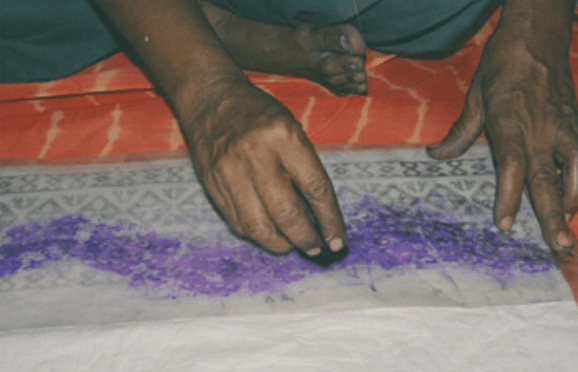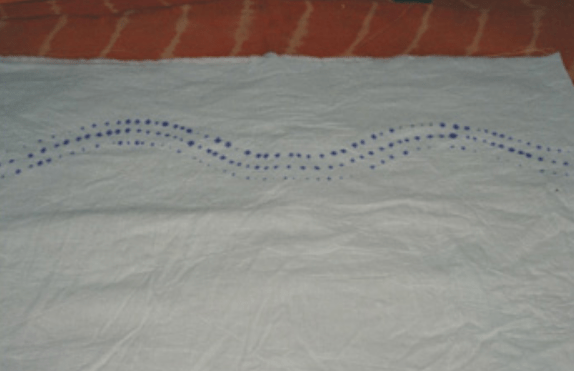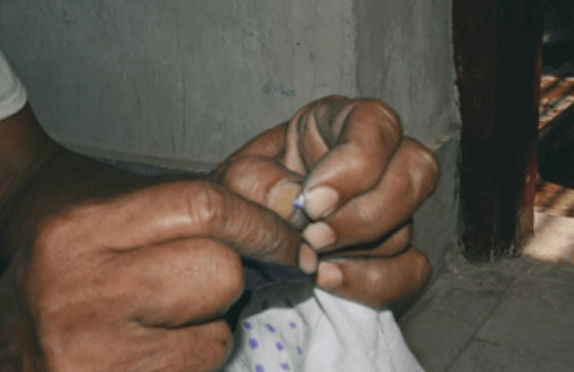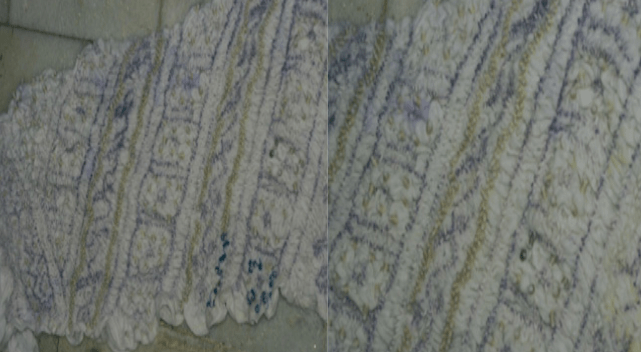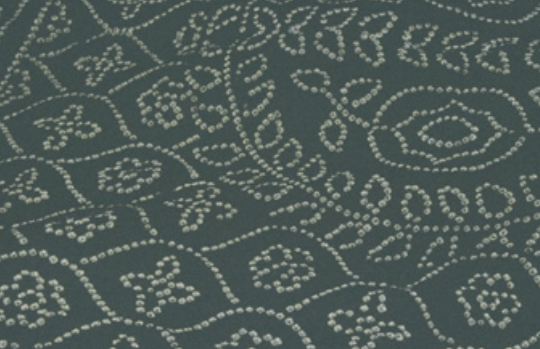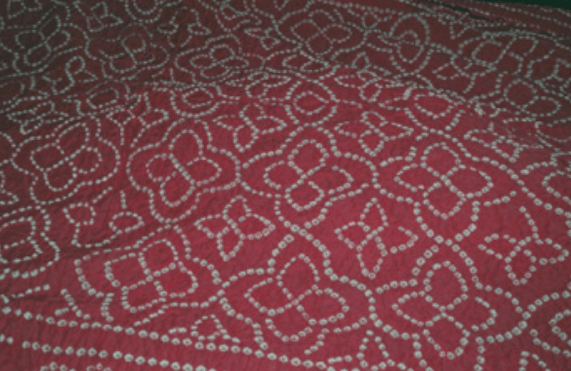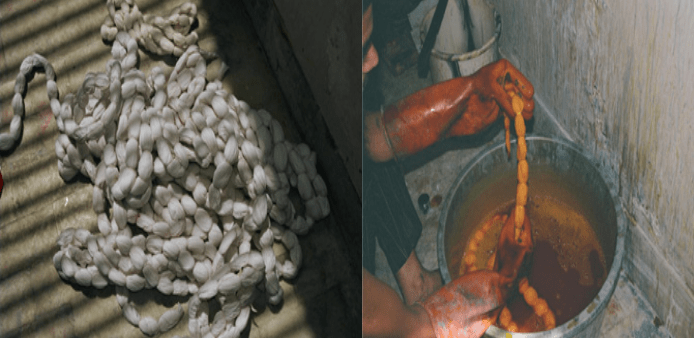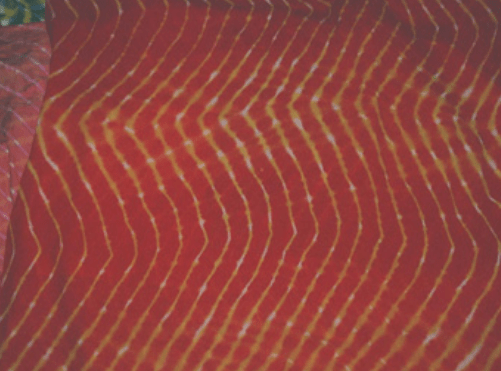The art of Bandhani is highly skilled process. The technique involves dyeing a fabric which is tied tightly with a thread at several points , thus producing a variety of patterns like Leheriya, Mothra, Ekdali and Shikari depending on the manner in which the cloth is tied.
History
Different forms of tie and dye have been practiced in India. Indian Bandhani, a traditional form of tie and dye, began about 5000 years ago. Also known as Bandhani and Bandhej, it is the oldest tie anddye tradition that is still practiced. Dyes were discovered by primitive man/woman in the form of extracts of various plants, flowers, leaves, bark, etc., which were applied to cloth and other fabrics. Even though color was applied they didn’t consider this dyeing. It was simply a form of embellishment. What was considered dyeing was the art of using color to form a permanent bond with fiber in a prepared dye bath. Ancient artists discovered that some dyes dissolved and gave their color readily to water, forming a solution which was easily absorbed by the fabric. Herbs and plants like turmeric and indigo were crushed to a fine powder and dissolved in water so that cotton material could be dyed into deep colours. These colours have been used in India since ancient times and are considered to be the origin of the art of dyeing. Throughout Asia, India and the Far East, traders packed tie and dye cloths as part of their merchandise.
Bandhani was introduced in Jamnagar when the city was founded 400 years ago. Bandhani fabrics reign supreme in Rajasthan and Gujarat which are home to an astounding variety of traditional crafts. Century-old skills continue to produce some of the most artistic and exciting wares in these two states and is popular all over the world. Rajasthan is a land of vibrant colors. These colors are a striking part of the life there and are found in the bustling bazaars, in fairs and festivals, in the costumes worn and in the traditional paintings and murals.
Regions
The art of Bandhani is practiced widely in Rajasthan, with Barmer, Jaipur, Sikar, Jodhpur, Pali Udaipur, Nathdwara and Bikaner being the main centers. Bandhani comes in a variety of designs, colors and motifs and these variations are region-specific. Each district has its own distinct method of Bandhani which makes the pattern recognizable and gives it a different name.
The centers of tie and dye fabrics in Gujarat are Jamnagar in Saurashtra (the water in this area brings out the brightest red while dyeing) and Ahmedabad. The craftsmen from Rajasthan are easily recognized because they grow the nail of their little finger or wear a small metal ring with a point to facilitate the lifting of cloth for tying. The Gujarati craftsmen, however, prefer to work without these aids as no damage is done to the cloth when one works with bare hands. The Bandhani regions are
Rajasthan
Marwar–Jodhpur
Mewar–Udaipur
Shekhawati–Sikar, Jhunjhunu, Churu
Gujarat
Jamnagar
Bhuj
Mandavi
Uttar Pradesh
Farukabad
Producer Communities
It is difficult to trace the origins of this craft to any particular area. According to some references it first developed in Jaipur in the form of Leheriya. But it is also widely believed that it was brought to Kutch from Sindh by Muslim Khatris who are still the largest community involved in the craft.
Raw Materials
The fabrics used for Bandhani are muslin, handloom, silk or voile (80/100 or 100/120 count preferably in voile). Traditionally vegetable dyes were used but today chemical dyes are becoming very popular. Various synthetic fabrics are also highly in demand. For tying knots mostly synthetic thread is used on the fabric.
The dominant colors in Bandhani are bright like yellow, red, green and pink. Maroon is also an all-time favorite. But with changing times, as Bandhani has become a part of fashion, various pastel colors and shades are being used. The Bandhani fabric is sold with the points still tied and the size and intricacy of the design varies according to the region and demand.
Bandhani forms the basic pattern on the fabric which is decorated further by various embroideries. Aari and gota work are traditional embroideries done in zari and are popular with Bandhani. These days a lot of ornamentation is done on Bandhani fabric to make it dressy and glittery for ceremonial occasions.
Popular Dyes Used in Bandhani
Vat dyes: Vat dyes are an ancient class of dyes based on the original natural dye, indigo, which is now produced synthetically. Both cotton and wool, as well as other fibers, can be dyed with vat dyes. ‘Vat dyeing’ means dyeing in a bucket or vat. It can be done whenever a solid, even shade, i.e., the same color over the entire garment, is wanted. It can be done using almost any dye, including fiber reactive dye, direct dye, acid dye, etc. The opposite of vat dyeing is direct dye application, for example, tie and dye.
Direct dyes: Also known as hot water dyes, direct dyes can be used with hot water and require no binding or exhausting agents. They are convenient but lack in color fastness and wash fastness. They are used on cotton, wool, silk and nylon. The colors of direct dyes are duller than those provided by reactive dyes. They can be found in powder form as well as in the form of a liquid concentrate. They do not require any form of ‘fixing’.
Napthol dyes: These are two sets of chemicals which, upon reaction, produce a third chemical, essentially colorful in nature. The fabric is dyed with one and later printed with the other. The chemical reaction produces a third color. However, the biggest drawback of this process is that there are just a few chemicals available which produce colors upon reaction.
Procion dyes: Procion fiber reactive dyes are specially formulated for cellulose fibers like cotton, linen and rayon. They also work well on silk. They are considered ‘cold water’” dyes. These dyes make fabrics great for solar dyeing, tie anddye and batik. As for the auxiliary chemicals, all you need is salt and soda ash. Synthrapol is optional but very helpful for rinsing out excess dye. Procion fiber reactive dyes can also be used on protein fibers but different auxiliaries are needed and the dye bath must be simmered.
Tools
In some places in Rajasthan the craftsmen wear a metal ring with a protruded point to facilitate the lifting of cloth for tying.
Process
The process, though relatively simple, is very time-consuming. The tying of the fabric is mostly carried out by women or young girls. The material generally used is a thin loosely woven silk known as georgette or cotton known as malmal.
The area of the fabric to be dyed is outlined using fugitive colors. Then a clear thin sheet of plastic, which has been pierced with pin holes, is kept over this area of the fabric and using fugitive colours an imprint of the desired pattern is transferred onto the fabric.
The craftsperson then pulls on a small area of the fabric where each is placed and winds thread tightly around the protruding cloth to form a knot or bhindi. The thread generally used is nylon thread.
After tying the knots the fabric is thoroughly washed to remove the imprint.
The cloth is then dipped in napthol for five minutes and dyed in yellow or another light color for two minutes.
Next it is rinsed, squeezed, dried and then tied again and dipped in a darker color. This is kept for three to four hours (without opening the knots) to allow the color to soak in.
During this process the small area beneath the thread resists the dye leaving an undyed dot. This is usually carried out in several stages starting with a light color like yellow, then after tying some more knots a darker coloris used and so on.
After the last dyeing process has been completed the fabric is washed and if necessary, starched. After the fabric is dried, its folds are pulled apart in a particular way releasing the knots and revealing their pattern. The result is a usually deep colored cloth with dots of various colours forming a pattern.
Very elaborate motifs are made, in tie and dye work. These include flowers, creepers, bells and jalas. Knots are placed in clusters each with a different name, for example, a single dot is called Ekdali, three knots is called Trikunti and four knots is called Chaubundi. Such clusters are worked intricately into patterns such as Shikargah (mountain-like), Jaaldar (web-like), Beldaar (vine-like) etc. Rajasthan is well known for its Leheriya pattern or pattern of waves, which symbolizes water waves. Only two colors are used which alternate each other in a pattern of stripes arranged diagonally. Originally, the two colors used were the auspicious colors of yellow and red. Turbans, odhn is and saris with the leheriya pattern are liked and worn all around year but carry a special meaning on and around the time of the Teej festival and monsoon.
In Bandhani, different colors convey different meanings. While red represents a bride, a yellow background suggests a lady has become a mother recently. Some of the most common designs are dungar-shahi or the mountain-pattern, boond that results in a small dot with a dark centre, tear shaped kodi, and the laddu-jalebior the swirling. In Tikunthi, circles and squares appear in a group of three, in ‘Chaubasi’ in groups of four and in Satbandi in groups of seven. (Boond is a dot with a dark centre and ekdali just a dot) Also different printers can call same design different names. Some names have become famous and some are used for reference reasons with the dyers and printers).
Market
Bandhani is being sold all over India and the demand has increased over the past few decades. Sales go up during the festive and wedding seasons in India. The bulk of the market is domestic with the main market being in Gujarat where most women wear Bandhani saris, shawls or odhnis. The odhnis are also decorated with mirrors, gotaandtassels to give it a richer and more decorative look. However, with the advent of the cheaper process of silk-screen printing, many of the poorer women wear printed cloth with a Bandhani design.
Changes in the Recent Years
Today, designers are using Bandhani fabric for contemporary clothing and it is being used to represent India in the international circuit. New colors and patterns are being used to cater to a wider market, though traditional red, yellow and pink still continue to be the all-time favorites!




